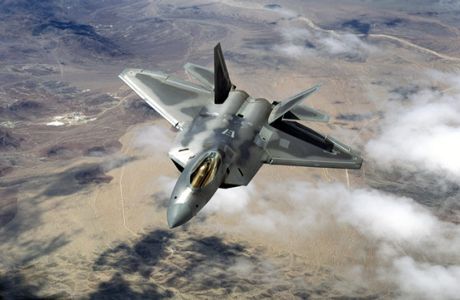US Defense Secretary Leon Panetta has ordered the Air Force to restrict flights of its most advanced fighter jet, the F-22, after some pilots complained of dizzy spells and blackouts, officials said Tuesday.
Since 2008, officials say at least a dozen F-22 pilots have reported suffering a lack oxygen but engineers have yet to figure out how to fix the problem.
Under Panetta’s decision the F-22 Raptor will no longer be conducting longer-range flights and would instead stay within reach of runways to ensure a pilot could land in an emergency, Pentagon spokesman George Little told reporters.
He said that “effective immediately, all F-22 flights will remain within the proximity of potential landing locations, to enable quick recovery and landing should a pilot encounter unanticipated physiological conditions during flight.”
The move meant that “long-duration airspace control flights” out of Alaska would be carried out by other aircraft, Little said, without offering more details.
Panetta also called on the Air Force to “expedite” the installation of a back-up oxygen system in the F-22 planes and to provide a monthly progress report on efforts to get to the bottom of the undiagnosed technical problem. The first back-up systems would be installed by December, officials said.
The announcement on the radar-evading F-22 marks the latest setback for the aircraft, the most expensive in the US fleet at $143 million per plane.
Touted as the most sophisticated fighter in the world, the F-22 has yet to be deployed in combat, and its cost overruns became a long-running political controversy until the program was curtailed.
Panetta’s decision followed a CBS “60 minutes” television report on May 6 in which two F-22 pilots said they had refused to keep flying the warplane because of safety fears. The two pilots have sought “whistleblower” legal protections through a Republican lawmaker.
Little denied the television interviews triggered Panetta’s announcement but pilots’ concerns “figured into his decision to direct these actions today.”
[ppgallery id=”33″]
“He is very concerned about pilot safety. And he wants safety concerns to be addressed at all levels of command through proper channels.”
The F-22 Raptor was grounded last year for four months after a spate of incidents with pilots saying they had passed out or suffered a lack of oxygen. The plane was cleared for flying in September 2011 but engineers are still trying to solve what they suspect may be a problem with the jet’s oxygen supply.
Despite safety concerns, the Pentagon said it would go ahead with plans to deploy some F-22s to a base in “Southwest Asia,” a reference to an airfield in the United Arab Emirates.
Some lawmakers and analysts have demanded that all F-22 flights be suspended until the Air Force figures out what is causing the fainting spells.
“Until the actual nature of the problem is uncovered, the pilots and ground crew remain at risk. The rationale for a fleet wide grounding remains clear,” said Winslow Wheeler, an outspoken critic of the Pentagon from the Center for Defense Information at the Project on Government Oversight.
A US Air Force scientific board carried out an elaborate inquiry but concluded the root cause remained unclear.
Air Force officers who presented the board’s findings in March said the number of incidents involving a lack of oxygen was extremely small, amounting to about one in every 9,000 flights.
The officers also said that effects of flying the F-22 are still not completely understood.
The F-22 flies at a higher altitude than other jets, above 50,000 feet, and relies solely on pressurized oxygen instead of a mixture of oxygen under pressure and air in the cockpit, according to the Air Force.
The plane is also faster and more agile than older fighters, with the pilot facing more gravitational forces than in other planes, officials say.
The design of the F-22, manufactured by Lockheed Martin, influenced plans for another new fighter still being developed, the F-35 Joint Strike Fighter, also produced by Lockheed Martin.
But officials said there was no sign the F-35 shared the F-22 Raptor’s oxygen problem.
“I think it’s safe to say that everybody in leadership is concerned about this, even in the defense industry environment,” Pentagon spokesman Captain John Kirby told the same briefing.
“But we are all going to work very hard to make sure that the problem gets solved for this aircraft and doesn’t get repeated in another.”











